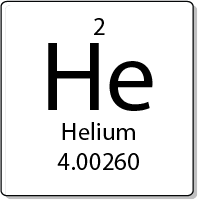
Helium is a chemical element with the symbol He and atomic number 2, is the second lightest element after hydrogen. This transparent gas was discovered in 1868 by Sir William Ramsay. Today, we know that a quarter of all atoms in the Universe are helium. It is one of the main gases in the atmospheres of the giant gas planets, such as Saturn. However, being so light, helium is very rare to find on Earth, as it escapes from our atmosphere into space. Thus, it was not until 1895 that chemists managed to collect a sample of helium gas from uraninite, a radioactive uranium ore. Today, helium is collected from subway deposits or is found mixed in natural gas and oil. It is a colorless, odorless, tasteless, non-toxic, inert monatomic gas that heads the noble gas series in the periodic table. Its boiling and melting points are the lowest among all the elements.
Helium is the second lightest element and is the second most abundant element in the observable universe, being present at about 24% of the total elemental mass. It is present in the Sun and other stars, and is also formed during the radioactive decay of some elements.
Unlike hydrogen, which is very reactive, helium is a noble gas and does not react at all. This property makes it a safe gas to use in objects such as balloons and aircraft. To liquefy it, it must be cooled to a temperature of -269 °C (-269 °F). Liquid helium is used for freezing at low temperatures, including the powerful magnets used to make magnetic levitation trains float on special tracks. Nuclear magnetic resonance scanners also use liquid helium for cooling.
It is also used in balloons, blimps, and airships, as a coolant for nuclear reactors and in cryogenics, and as a protective gas in welding and other industrial processes.

Electron configuration
The electron configuration of an element describes the arrangement of electrons in the atoms of that element, and be used to predict its chemical properties and reactivity.
In the electron configuration notation, the letters "s", "p", "d", and "f" represent the different types of atomic orbitals, and the superscripts indicate the number of electrons in each orbital. The orbitals are filled in a specific order, starting with the lowest energy orbital and working up.

Emission spectra
Each element in the periodic table presents its own unique emission spectra, which is determined by the energy levels of its electrons. When an electron in an atom is excited to a higher energy level, it can de-excite by emitting a photon of light with an energy equal to the difference between the two levels. This results in a characteristic emission line in the spectra (which corresponds to specific wavelengths of light). These spectra are usefull to identify the elements present in a sample.

Symmary of properties (He)
| Atomic weight | 4.002602(2) |
| Discoverer (year) | Ramsey, Sir William & Cleve, Per Teodor (1895) |
| Natural form | gas |
| Electron configuration | 1s2 |
| M.p. (ºC) | -272 |
| B.p. (ºC) | -269 |
| Earth's crust abundance (ppm) | 0.008 |
| Isotope (abundance %) | 3He (0.000134), 4He (99.999866) |
| Density (g/cm3) | 0.18 |
| vdW radius (pm) | 140 |
| Covalent radius (pm) | 37 |
| Electronegativity (Pauling) | |
| Vaporisation enthalpy (Kj/mol) | 0.08 |
| Fusion enthalpy (kJ/mol) | - |
| Specific heat capacity (J/g·K) at 25ºC and 1 at | 5.19 |
| Thermal conductivity (W/cm·K) at 25 ºC and 1 at | 0.002 |
| Oxidation number | 0 |
| Electronic affinity (eV) | |
| 1st Ionization energy (eV) | 24.5874 |
Definition of terms in the previous table
- Atomic weight: The average mass of an element's atoms, typically given in atomic mass units (amu).
- Natural form: The most stable and abundant form of an element that occurs naturally in the environment.
- Electron configuration: The arrangement of electrons in an atom or molecule.
- Melting point: The temperature at which a solid substance turns into a liquid.
- Boiling point: The temperature at which a liquid substance turns into a gas.
- Earth's crust abundance (ppm): The concentration of an element in the Earth's crust, typically given in parts per million (ppm).
- Isotope (abundance %): A variant of an element that has the same number of protons in the nucleus, but a different number of neutrons. The abundance of an isotope is the percentage of the isotope in a sample of the element.
- Density (g/cm3): The mass of a substance per unit volume.
- vdW radius (pm): The radius of an atom or molecule as predicted by the van der Waals model, typically given in picometers (pm).
- Covalent radius (pm): The distance from the center of an atom to the center of another atom with which it is bonded covalently, typically given in picometers (pm).
- Electronegativity (Pauling): A measure of an atom's ability to attract electrons in a chemical bond, based on the Pauling scale.
- Vaporisation enthalpy (kJ/mol): The amount of energy required to convert a substance from a liquid to a gas at a constant temperature.
- Fusion enthalpy (kJ/mol): The amount of energy required to convert a substance from a solid to a liquid at a constant temperature.
- Specific heat capacity (J/g·K) at 25ºC and 1 at: The amount of heat required to raise the temperature of 1 gram of a substance by 1 degree Celsius at a constant pressure.
- Thermal conductivity (W/cm·K) at 25 ºC and 1 at: The ability of a substance to conduct heat, typically given in watts per centimeter per kelvin.
- Oxidation number: A positive or negative integer that represents the number of electrons that an atom has gained or lost in a chemical compound.
- Electronic affinity: The energy change associated with adding an electron to a neutral atom to form a negative ion.
- 1st Ionization energy: The energy required to remove the most loosely bound electron from a neutral atom.
Back to the Periodic Table of the Elements.